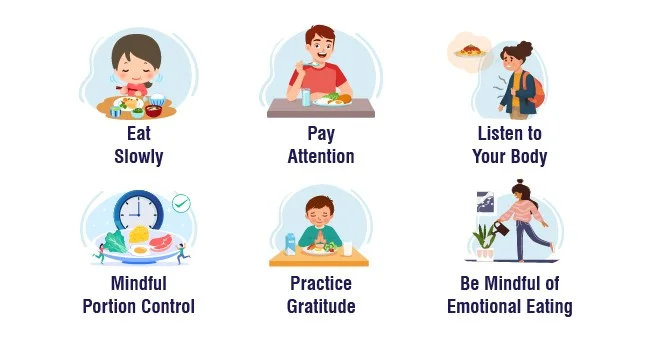Mindful eating is a practice rooted in paying attention to the what, why, and how of eating. By fostering an awareness of physical hunger and satiety cues, mindful eating encourages individuals to savour their meals, leading to a more satisfying and balanced relationship with food. The importance of adopting mindful eating techniques cannot be understated, as they offer a path to balanced nutrition practices and a holistic view of health that transcends the simple goal of weight loss.
This article will guide readers through the core aspects of mindful eating, from understanding its principles to integrating mindful eating techniques into daily life for weight management and nutritional balance. Readers will explore the benefits of mindful eating for weight loss, how to practice these techniques effectively, and the crucial role of awareness in combating emotional eating. Additionally, we will provide insights on how to weave mindful eating into one’s lifestyle, ensuring that the journey towards a healthier self is about shedding pounds and cultivating a nourishing and conscious relationship with food and eating habits.
Understanding Mindful Eating
Mindful eating is the process in which individuals pay closer attention to their food and the sensations it evokes, distinguishing between physical and emotional hunger. It is rooted in mindfulness, a Buddhist concept, a form of meditation focusing on awareness of emotions and bodily sensations. This technique aims to manage eating habits more effectively, promoting weight loss, reducing binge eating, and enhancing overall well-being. Mindful eating involves paying attention in a specific way: on purpose, in the present moment, and non-judgmentally, as defined by Jon Kabat-Zinn, a leader in mindfulness-based stress reduction.
Principles of Mindful Eating

- Eating Slowly Without Distraction: Engaging fully in the eating experience without external distractions.
- Listening to Physical Hunger Cues: Eat only until complete and distinguish between true hunger and other eating triggers.
- Engaging the Senses: Noticing the colours, smells, sounds, textures, and flavours of food enhances the eating experience.
- Acknowledging Food Responses Without Judgment: Recognising likes, dislikes, or neutral responses to food choices.
- Cultivating Gratitude: Appreciating food’s nourishment and the efforts involved in its production, fostering a deeper connection with food.
- Nonjudgmental Presence: Observing thoughts and feelings about food without self-criticism fosters a compassionate eating approach.
Mindful eating also considers the broader aspects of meals, such as their origin, preparation, and environmental impact. It encourages a plant-based diet for health and environmental reasons and suggests eating in modest portions to avoid overeating and food waste. By adopting these principles, individuals can foster a more enjoyable and mindful relationship with food, leading to healthier eating habits and improved well-being.
Preventing Overeating and Binge Eating
Mindful eating tips significantly reduce the frequency and severity of binge eating episodes by fostering an awareness of emotional and physical hunger cues. This awareness allows individuals to distinguish between eating out of emotional need and physical hunger, thereby preventing overeating. Moreover, mindful eating practices encourage savouring food slowly, which aligns with research suggesting that slower eating can lead to feeling fuller sooner, thus preventing overeating.

Mindful eating enhances the digestive process by encouraging slower eating and thorough chewing, which aids in the efficient breakdown and absorption of nutrients. This practice activates the parasympathetic nervous system, improving peristalsis and the secretion of digestive enzymes and hormones essential for optimal nutrient absorption.
Weight Management
Adopting mindful eating practices can aid in weight loss by changing eating behaviours and reducing stress associated with eating, critical factors in managing weight. By increasing awareness of food-related triggers and providing the freedom to choose a response to them, mindful eating supports making healthier food choices consistent with desirable health benefits, often leading to eating less and selecting foods that support weight management. Additionally, studies have indicated that mindful eating may effectively treat common, unhealthy behaviours like emotional and external eating, which benefit weight management.
Incorporating mindful eating into one’s lifestyle supports weight management and contributes to a balanced nutritional intake by fostering a greater appreciation for the quality of food consumed. This holistic approach to eating encourages a healthier relationship with food, emphasising the importance of quality over quantity and the nutritional value of food choices.
Ways to Practice Mindful Eating
Slow Down and Savor Each Bite
- Begin by reawakening the pleasure of eating, focusing on slowing down and paying full attention to each bite.
- Engage in savouring food like a wine connoisseur, taking time to appreciate the bouquet, rolling the food around in your mouth, and detecting different ingredients.
- Implement the habit of chewing each bite at least fifteen times before swallowing to enhance the taste and improve digestion.
- Make an effort to put down your fork or spoon after each bite, ensuring you don’t rush through your meal and fully savour the food.
Pay Attention to Hunger and Fullness Cues
- Utilise the hunger and fullness scale, a tool from the intuitive eating framework, to reconnect with your body’s internal cues and guide your eating.
- According to the scale’s guidelines, start eating when your hunger is at level 3 (moderately hungry) and aim to stop at about a 6 or 7 (comfortably full or satisfied).
- Check-in with your body regularly during meals to assess your fullness level and decide if it’s time to stop eating.
Avoid Distractions While Eating

- Eliminate distractions such as television, phones, or work to focus solely on the eating experience.
- Practice eating in silence or a quiet place, which can help recognise hunger and fullness cues more effectively.
- Minimising distractions allows you to be fully present during meals, enhancing the overall mindful eating experience.
By implementing these practices at every meal, you are creating a mindful relationship with food, leading to improved meal satisfaction, better digestion, and a healthier approach to eating.
Mindful Eating and Emotional Eating
Recognising Emotional Triggers
Emotional eating is a response to various triggers, not just negative emotions such as stress, sadness, or boredom, but also positive ones like celebration or reward. Identifying these triggers is crucial as the first step towards addressing emotional eating. This involves asking oneself critical questions to differentiate between eating out of physical hunger and emotional need. Emotional hunger can manifest suddenly and demand immediate satisfaction, often leading to the consumption of specific comfort foods, whereas physical hunger develops gradually. Recognising these triggers and understanding the difference between emotional and physical hunger is essential in managing emotional eating.
Finding Alternative Coping Mechanisms
Once emotional triggers are identified, finding healthier coping mechanisms is vital. Instead of turning to food, individuals can engage in activities that address their emotional needs without eating. This can include physical activities like taking a brisk walk or engaging in light exercise, diverting attention from food and positively impacting emotional well-being. Additionally, exploring hobbies or interests that stimulate the senses—such as listening to music, gardening, or aromatherapy—can provide emotional relief without the guilt associated with emotional eating. Developing these alternative coping mechanisms is crucial in eliminating the emotional eating cycle and fostering a healthier relationship with food.
Addressing emotional triggers and finding healthier ways to cope can help individuals take significant steps towards overcoming emotional eating. This approach aids in weight management and improves overall emotional and physical health.
Incorporating Mindful Eating into Your Lifestyle
Start with One Meal or Snack a Day
Focus on one meal or snack daily to integrate mindful eating into your lifestyle seamlessly. This approach allows individuals to gradually adapt to the practice without feeling overwhelmed. As comfort with the technique grows, mindful eating can be expanded to more meals, fostering a deeper connection with eating and the sensations it brings.
Practice Mindful Grocery Shopping
Mindful grocery shopping is an essential aspect of adopting a mindful eating lifestyle. Meal prepping and buying snacks for the week based on your plans can prevent impulse buys and ensure that all ingredients needed for nutritious meals are obtained. Spending most of the shopping time in sections with fresh produce, meats, and dairy encourages healthier, less processed food choices. Additionally, being mindful of marketing strategies and sticking to the shopping list can help maintain focus on healthful decisions. Embracing the “I get to choose” attitude can transform the shopping experience into gratitude and joy, recognising the abundance of healthy options available.
Create a Peaceful Eating Environment
Creating a calm and inviting meal environment can enhance a mindful eating experience. Eliminating distractions like screens and setting the table aesthetically pleasing can help individuals be fully present during their meals. Engaging the senses by arranging food attractively and using appealing dishes encourages a deeper appreciation for the meal, making the eating experience more enjoyable and mindful.
Conclusion – Mindful Eating
Through exploring mindful eating, we have uncovered an approach to weight management and nutritional balance that goes beyond traditional dieting methods. By emphasising the importance of being present and engaging fully with the eating experience, eating minfdully offers a path to a healthier relationship with food and an enhanced quality of life. The principles discussed in this article shows the impact of mindfulness on combating emotional eating, improving digestion, and promoting a sense of well-being through a gratifying connection with food. It’s clear that this is not merely a diet trend but a sustainable, holistic approach to eating and living.





